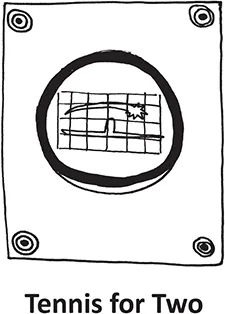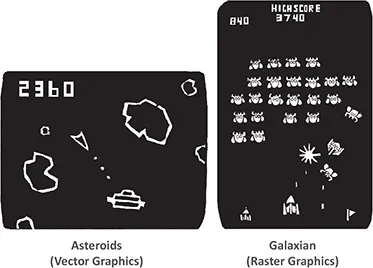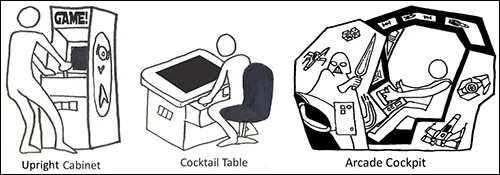Level 1
Welcome, N00bs!
THIS CHAPTER IS written especially for people who are new to video games and how they are made. I talk about what is a game, who makes them, and what kinds of games there are. It’s pretty basic stuff and if you already know it all and are not a n00b,1 feel free to skip it. However, you are going to be missing out on a lot of great stuff. Don’t say I didn’t warn you.
Within the academic gaming community, there are many different definitions for what qualifies as a game. Some scholars insist that “a game needs to be a closed formal system that subjectively represents a subset of reality.”2 Others say that games need to have “players in conflict with each other.”3 I think those definitions are trying too hard to sound smart.
Game definitions are often simpler than that. Bernard Suits wrote that “playing a game is a voluntary effort to overcome unnecessary obstacles.”4 This is a pretty amusing definition, but still a bit too scholarly for my taste. Let’s keep things simple. Let’s consider hand ball. You need only one player for hand ball. Where are the other players to be in conflict with? Bouncing a ball against a wall without missing it is hardly a metaphor for reality—unless you lead a very boring life. Let’s face it, sometimes a ball bouncing against a wall is just a ball bouncing against a wall.
Playing hand ball may therefore seem like a time-waster, but a time-waster becomes a game when you add rules and an objective. A rule may be to throw the ball with your right hand and catch it with your left, or to not drop the ball. A victory condition could be that you have to catch the ball ten times in a row. A failure state would be if you violated any of the rules or victory conditions. When those criteria have been met, you have created a game. Ironically, while simple, hand ball was enough of a game to inspire the creators of one of the earliest video games: Tennis for Two.
So, let’s ask this basic question:
- Q: What is a game?
- A: A game is an activity that
- Requires at least one player
- Has rules
- Has a win and/or lose condition
That’s pretty much it.5
Now that you know what a game is, let’s ask:
- Q: What is a video game?
- A: A video game is a game that is played on a video screen.
Sure, you can start complicating the definition and add requirements about devices, peripherals, control schemes, player metrics, boss fights, and zombies (and don’t worry; we’ll tackle these things soon enough). But by my reckoning, that is pretty much as simple as it gets.
Oh, there’s one other thing to consider at this early stage. A game needs a clear objective so the player knows what the goal is. You should be able to sum up a game’s objectives quickly and clearly. If you can’t, you’ve got a problem.
Danny Bilson, THQ’s former EVP of Core Games, has a great rule of thumb about a game’s objective. He says that you should be able to sum up the game’s objectives as easily as those old Milton Bradley board games did on the front of their box. Check out these examples taken from real game boxes:
- Battleship: Sink all of your opponent’s ships.
- Operation: Successful operations earn “Money.” Failures set off alarms.
- Mouse Trap: Player turns the crank, which rotates gears, causing lever to move and push the stop sign against shoe. Shoe tips bucket holding metal ball. Ball rolls down rickety stairs and into rain pipe, which leads it to hit helping hand rod. This causes bowling ball to fall from top of helping hand rod through thing-a-ma-jig and bathtub to land on diving board. Weight of bowling ball catapults diver through the air and right into wash tub, causing cage to fall from top of post and trap unsuspecting mouse.
Okay, let’s just ignore that last one. The lesson is, you need to keep your game objectives simple. Speaking of simple games, let’s take a moment to travel back to the dawn of video games. They had to start somewhere, right?
A Brief History of Video Games
The 1950s. The dawn of television, 3-D movies, and rock ‘n’ roll. Video games were invented in the 1950s too, only they were played by very few people, on very large computers. The first video game programmers were students in the computer labs of large universities like MIT and employees of military facilities at Brookhaven National Laboratories. Early games like OXO (1952), Spacewar! (1962), and Colossal Cave (1976) had very simple or even no graphics at all. They were displayed on very small black-and-white oscilloscope screens.
After playing Spacewar! at the University of Utah’s computer lab, future Atari founders Ted Dabney and Nolan Bushnell were inspired to create Computer Space, the first arcade video game, in 1971. While (despite the name) the first arcade games could be found in bars, arcades dedicated to video games began appearing by the late 1970s.
Early arcade games were rendered using either vector graphics (images constructed from lines) or raster graphics (images constructed from a grid of dots called pixels). Vector graphics allowed for bright, striking images like those seen in Battlezone (Atari, 1980), Tempest (Atari, 1981) and Star Wars (Atari, 1983) while raster graphics spawned cartoon-inspired characters like Pac-Man (Namco, 1980) and Donkey Kong (Nintendo, 1982). These early characters became pop culture icons overnight; appearing in everything from cartoons and t-shirts to pop-music and breakfast cereals.
During the early 1980s, three styles of game machines dominated arcades: uprights (cabinets which the player stood in front of while playing), cocktail tables (arcade games set into the top of a small table, allowing the player to sit down while playing), and cockpits (elaborate game cabinets that allowed the player to lean or sit down to further enhance the gaming experience).
In the mid-1980s, arcades began springing up everywhere, and video games took the world by storm. Game genres and themes became more varied, while gaming controls and cabinets became more elaborate with realistic controllers and beautiful graphics decorating uniquely designed cabinets. You could sit back to back in a two-player spaceship cockpit while playing Tail Gunner (Vectorbeam, 1979), battle Klingons from a replica of Captain Kirk’s command chair in Star Trek (Sega, 1982), or “drive” in a miniature Ferrari Testarossa that moved and shook in Out Run (Sega, 1986). By the late 1990s, many arcade games started to resemble single-rider theme-park rides complete with rideable race horses, gyroscopically moving virtual simulators, and fighting booths that allowed players to battle virtual foes using actual punches and kicks. The most elaborate of these arcades was Virtual World’s BattleTech Centers—steampunk-themed arcades with linked “battle pods”6 that allowed eight players to fight each other while stomping around in giant virtual “mechs.” But these elaborate arcade games required lots of floor space and were very expensive to maintain. In the late 1990s, home systems began to rival and eventually surpassed the graphics seen in most arcade games. Arcades went out of business by the dozens. The video games were replaced with more lucrative redemption machines7 and games of skill like skeeball, whack-a-mole, and basketball hoops. The golden age of video game arcades was over.
But you can’t keep a good idea down. Since the late 90s arcades have become social and virtual experiences. LAN gaming centers combine retail and social space to allow players to play computer and console games on a per-hour basis. Many have upgraded to feature large-scale gaming experiences held in movie theater-sized venues. Internet cafes are similar to LAN centers but with an emphasis on cultivating a café-style environment. Meanwhile, the few arcade game manufacturers left are creating even more epic experiences—Namco’s Deadstorm Pirates (2009) and Dark Escape 4D (2013) are more like theme-park dark rides8 than arcade games.
If arcades are becoming more like theme-park rides, theme parks are becoming arcades. Theme park creators are gamifying their attractions, turning dark rides into full sensory arcade games. Theme parks around the world such as Futuroscope and Warner Brother’s Movie World offer several virtual games and interactive dark rides. For example, Toy Story Midway Mania! at Disney’s California Adventure (2008) whisks a four-player cart past a succession of giant video screens where players compete in a variety of carnival-style shooting games. Players use cart-mounted pop-guns to shoot virtual projectiles at on-screen targets. When some targets are hit, players are sprayed with air or water mist effects, creating an immersive “four-D” effect. The cycle of modern arcade gaming and home gaming has come full circle with the release of a Wii version of the Toy Story Midway Mania! attraction for home use (minus the air and water effects).
Happily, historians and academics have realized the impact and importance of video gaming. Museums have sprung up around the world, such as the Computerspielemuseum Berlin and New York’s Museum of the Moving Image. Retro 80s arcades are making a comeback, complete with glo-in-the-dark carpet and tokens, offering players another chance to play their favorite vintage arcade games and revisit their old-school home system favorites.
A console is a gaming platform that can be used in the home. A microprocessor runs the electronic device, which sends a video display signal to the user’s TV set or monitor.9 Unlike the dedicated controllers of an arcade machine, a home console controller has enough buttons, triggers, and analog controls to allow for a variety of games to be played. And unlike the dedicated motherboards in early arcade games, which could hold only one game, console games use cartridge, CD, and DVD media to allow players to quickly change games. The first commercial home console was the Magnavox Odyssey (1972) created by gaming pioneer Ralph Baer. Technologically, the Odyssey was pretty far ahead of its time. It featured an analog controller, games on removable ROM cartridges, and a light gun—the first gaming peripheral. From the late 1970s onwards, there have been many home consoles. Some of the more popular and/or well-known previous generation ones include the Atari 2600 and Jaguar, the Mattel Intellivision, the ColecoVision, the Nintendo Entertainment System and Super Nintendo, ...





